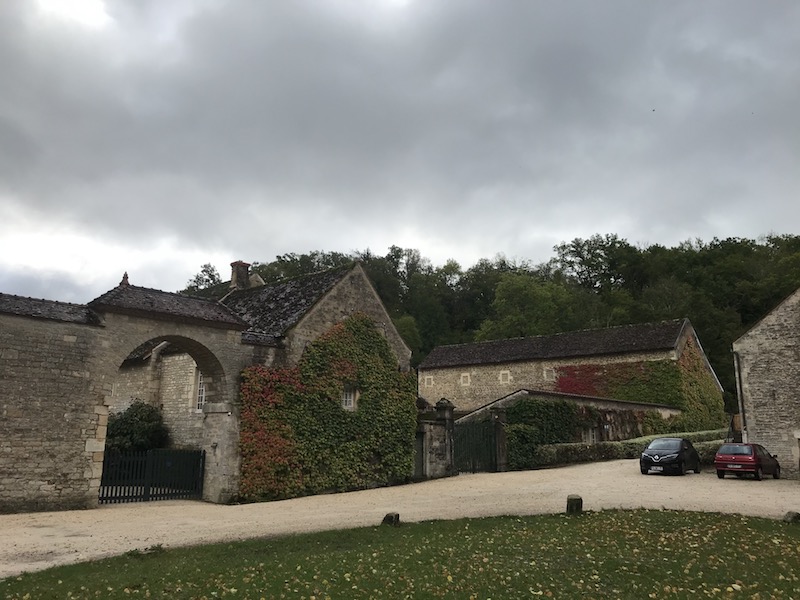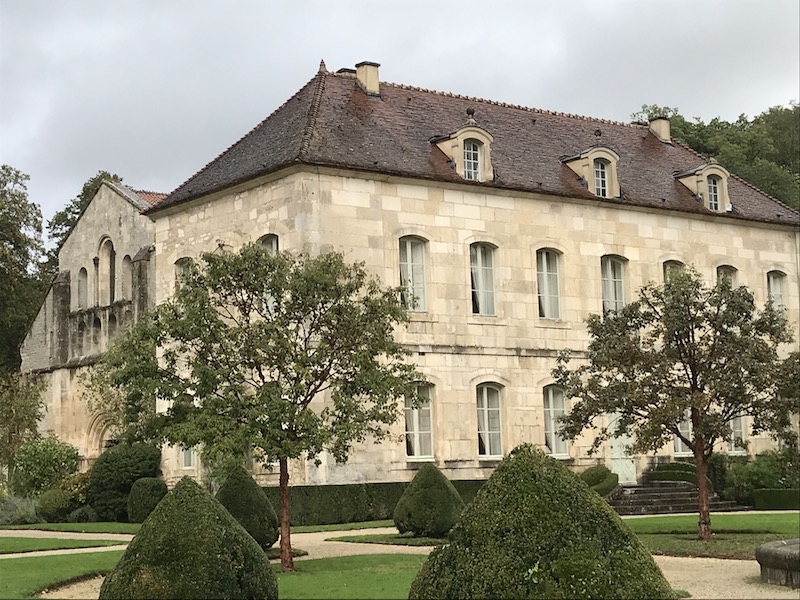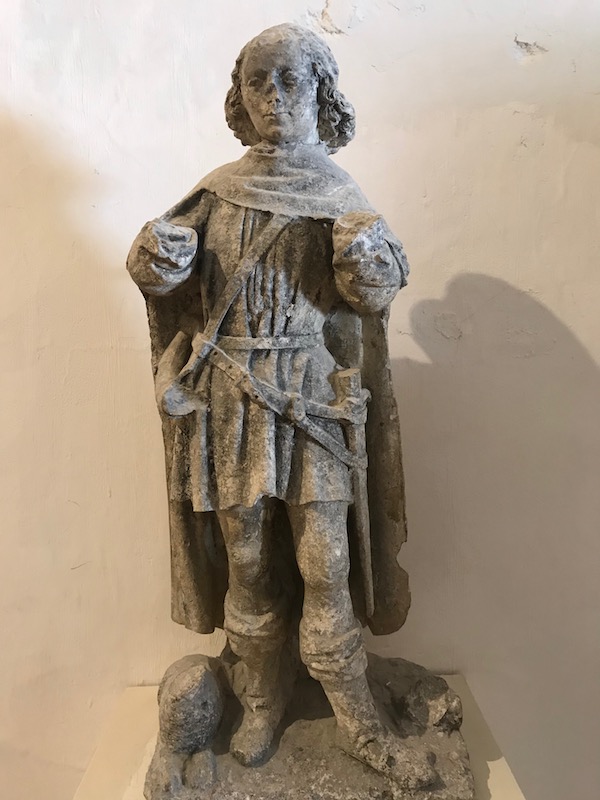Our Blog - Abbey of Fontenay, France
The Abbey of Fontenay is a former Cistercian abbey, founded by Saint Bernard of Clairvaux in 1118, and built in the Romanesque style. It is one of the oldest and most complete Cistercian abbeys in Europe. Of the original complex comprising church, dormitory, cloister, chapter house, caldarium, refectory, dovecote and forge, all remain intact and well-maintained except for the refectory (which was demolished in 1745). The great thing about this abbey was that Lucy was allowed everywhere! It remained an active abbey until the French Revolution. The last 8 monks left the abbey in 1790 and it was then turned into a paper mill. Major restoration works started in 1906 when Edouard Aynard bought all of the buildings and decided to return it to its former medieval state. A few of the buildings were added in the 18th century, and you can definitely tell the difference in the building style.
The building that is now the entry served roughly the same purpose then as it does now ... it marked the boundary between its closed and protected space and the outside world.


An overall view, I'll talk about the individual buildings later. The small building on the left is the dovecot and the kennels, then the large building to the right is the "new" home for the commanding abbots (18th century). The pointed roof at the very back, between those 2 buildings, is the abbey church. In the second picture, the Seguin gallery (19th century) is in the middle and then the 16th century l'enfermerie building hidden by the trees. The 3rd picture shows the 12th century forge building.



The round dovecote was built in the 13th century and has walls that are more than a meter thick. Some people may not know what a dovecote is because I didn't know before moving to France and seeing them everywhere. Sometimes called pigeonniers, they are basically "apartment blocks" to raise pigeons. Dovecotes were used primarily in the 16th and 17th centuries to keep pigeons for their meat. (The birds’ guano was also collected and used for fertilizer, gunpowder, and tanning hides.) At the time, farmers could not rely on their usual crops to feed livestock such as pigs and cows. They were therefore looking for alternative sources of meat. Pigeons were easy to maintain: as natural foragers, they spent their days seeking food, then came home to roost at night. A farmer needed only to have a tower lined with nest-friendly alcoves in order to keep hundreds of squabs at the ready.

This 18th century building served as the lodgings for the commendatory Abbots, those nominated by the king when the Abbey passed into the hands of the Commendatum in 1574. You can easily compare this building to the dovecote (previous picture) and see a difference in the construction. The older buildings tend to use irregularly-shaped and sized stones while this building seems to have regular stone pieces.

The Seguin gallery was built in 1850 and sits where the original refectory and kitchens were. It was built by Marc Seguin, a 19th century French scientist who is known for building the first railways in France.

The crowning glory is the abbey church. It was started in 1139 and consecrated in 1147 by Pope Eugene III. Lucy is patiently waiting outside to be able to go into what I think is her first French church.

Abbey Church of Fontenay is one of the oldest Cistercian churches in the world. Built between 1139 and 1147, it is also one of the few Cistercian churches of the 12th century to have survived intact until today. You may think that the church is pretty plain, but Saint Bernard and the Cistercian Order did not want anything in the church to distract the eye from being turned to God. That is why this building was designed with simplicity and is a model of Burgundian Romanesque architecture: Latin cross plan, bare facade, simple foliage sculptures for the capitals, and single row of side windows. Massive piers sustain high, large barrel vaults consisting of pointed arches and transverse pointed arches.


The choir is covered with glazed tiles of the 12th and 13th centuries. There is also a remarkable carved altarpiece of the 13th century, and a set of gravestones including that of the English bishop who financed the construction of the church.




In the North transept is a statue of the Virgin and child called "Virgin of Fontenay". This statue is one of the most remarkable examples of Burgundian sculpture of the late 13th century. The statue was sold at the time of the French Revolution to a family from a nearby village for almost nothing and placed on the family tomb. After more than a century being exposed to the weather it was bought back in 1929.

The cloister is the heart of the monastery. While many cloisters were destroyed during the French Revolution, the 12th century cloister here remains intact. It served as both a place of communication between all the rooms of the monastery and a place of meditation. The Romanesque galleries form a rectangle and despite a variety of pillars, columns and capitals, all of which reflect the simplicity of Cistercian architecture, it all looks like it goes together.


The chapter house is next to to the cloister. Every morning, the monks would gather here to read a chapter of the Rule of Saint Benedict, hence the name of the room. Then the the daily work assignments were given out among the monks.

Upstairs from the chapter house is the dormitory, a large indoor hall with a magnificent oak frame that looks like the hull of an overturned ship. The monks slept, fully clothed, on simple spaced benches. This original structure was destroyed in a fire and this ceiling dates from the 15th century.

The Forge was built away from the religious buildings of the monastery, so as to mark a clear separation between prayer and work, which were the two main activities of the monks. It dates from the late 12th century. This building, which measures more than 50 meters long, is reinforced by a series of powerful buttresses that evoke intense activity. Archaeologists who have studied the Forge and iron mines nearby believe it is one of the oldest metallurgical plants in Europe. It probably had two furnaces and several mills operating hydraulic hammers, one of which was recently reconstituted. A hydraulic hammer was reconstituted in 2008 as part of a European project involving 7 technical schools. This hammer is a functional replica of hammers that would have been used by the monks. A water wheel, which uses hydraulic installations created by monks, operates a hammer that allowed refining metal coming from the furnaces. This mechanical method, prior to the invention of modern blast furnaces, enabled a strong increase in productivity.



Next to the forge is a pond that the abbey had used as a fish farm.

This building, the enfermerie, dates back to the 16th century. The name somewhat translates to "the lockdown" and while some people say it was used as a prison, most people believe it was the place where the Abbeys most precious possessions were stored.

One statue that was on display in the small museum is entitled "Le Chasseur", dates from the 14th century.
